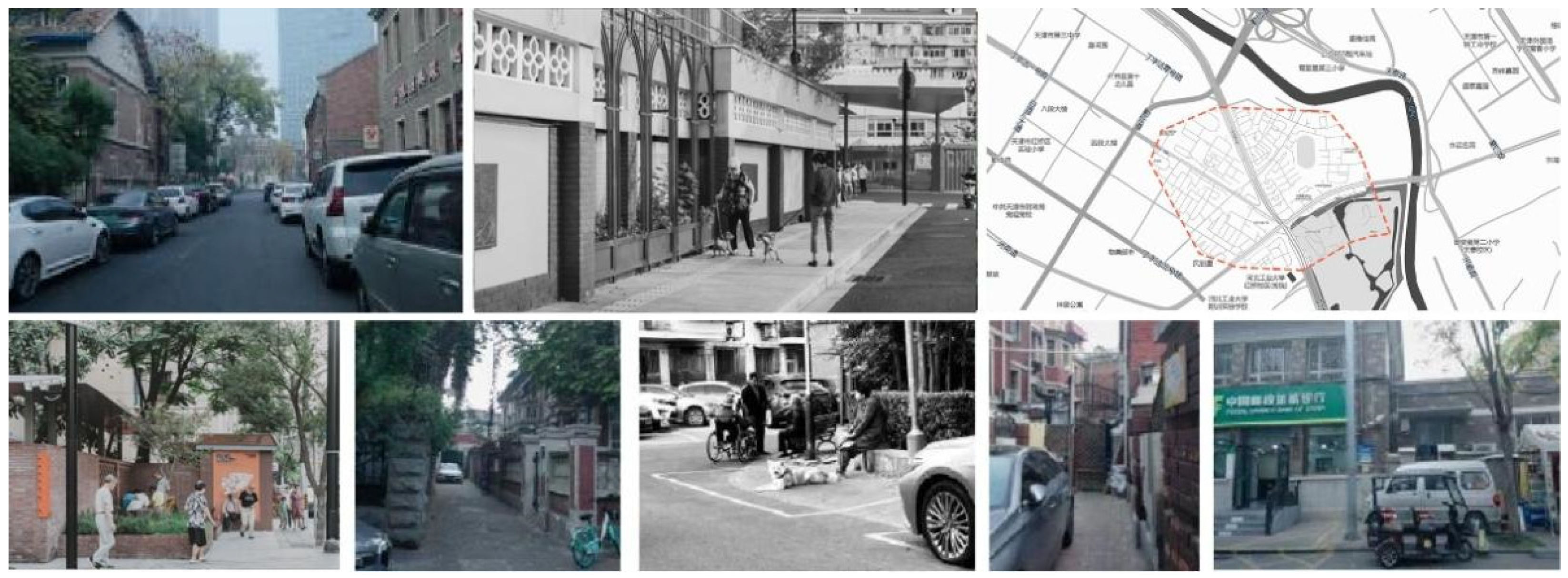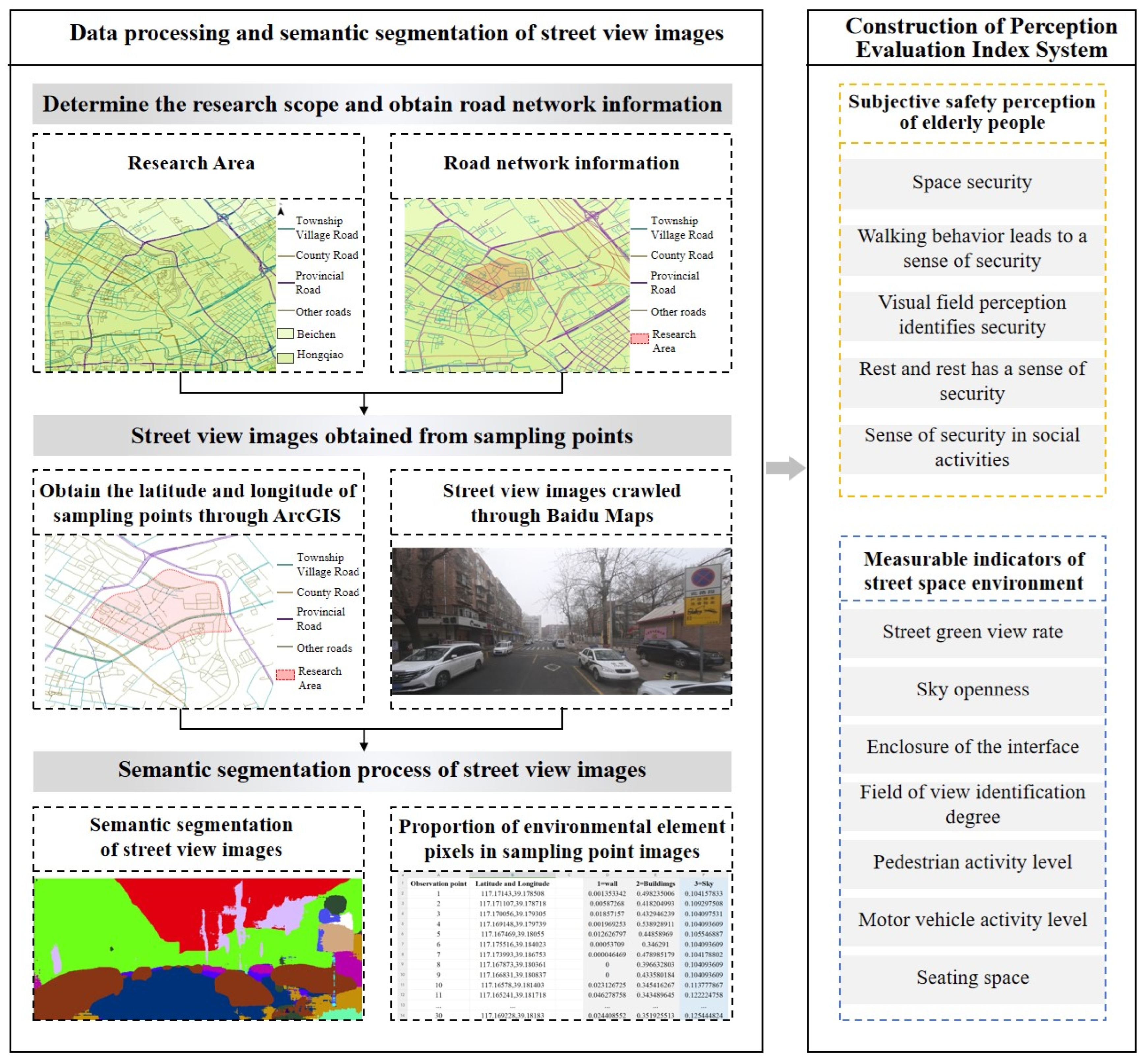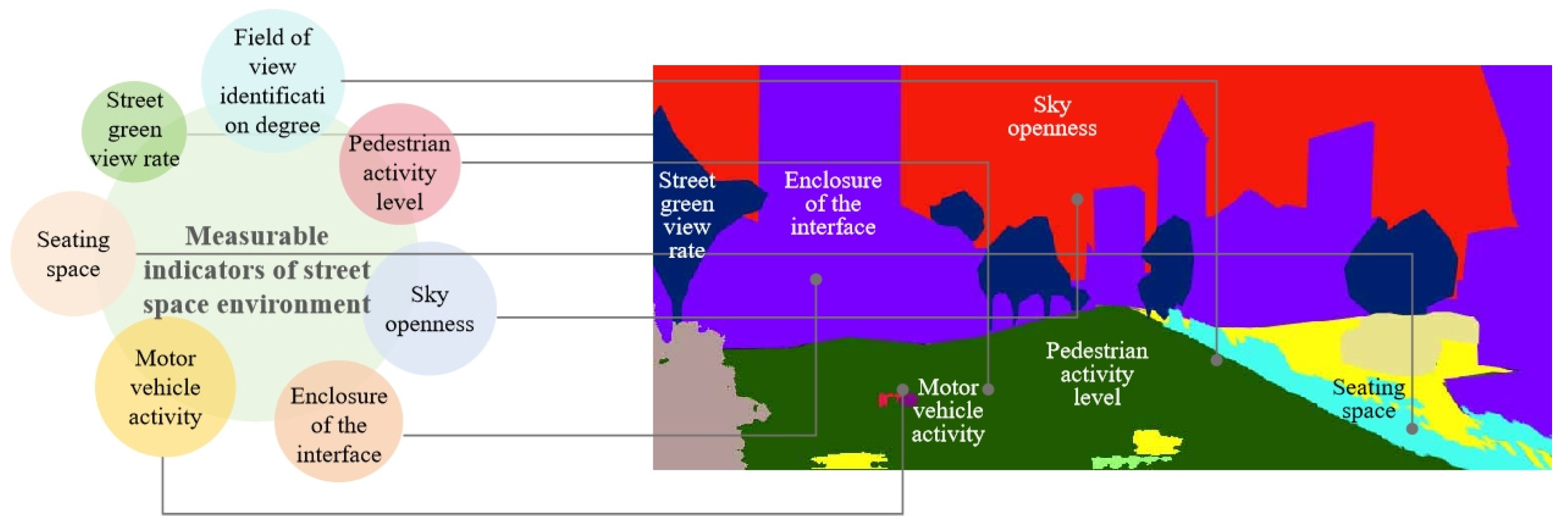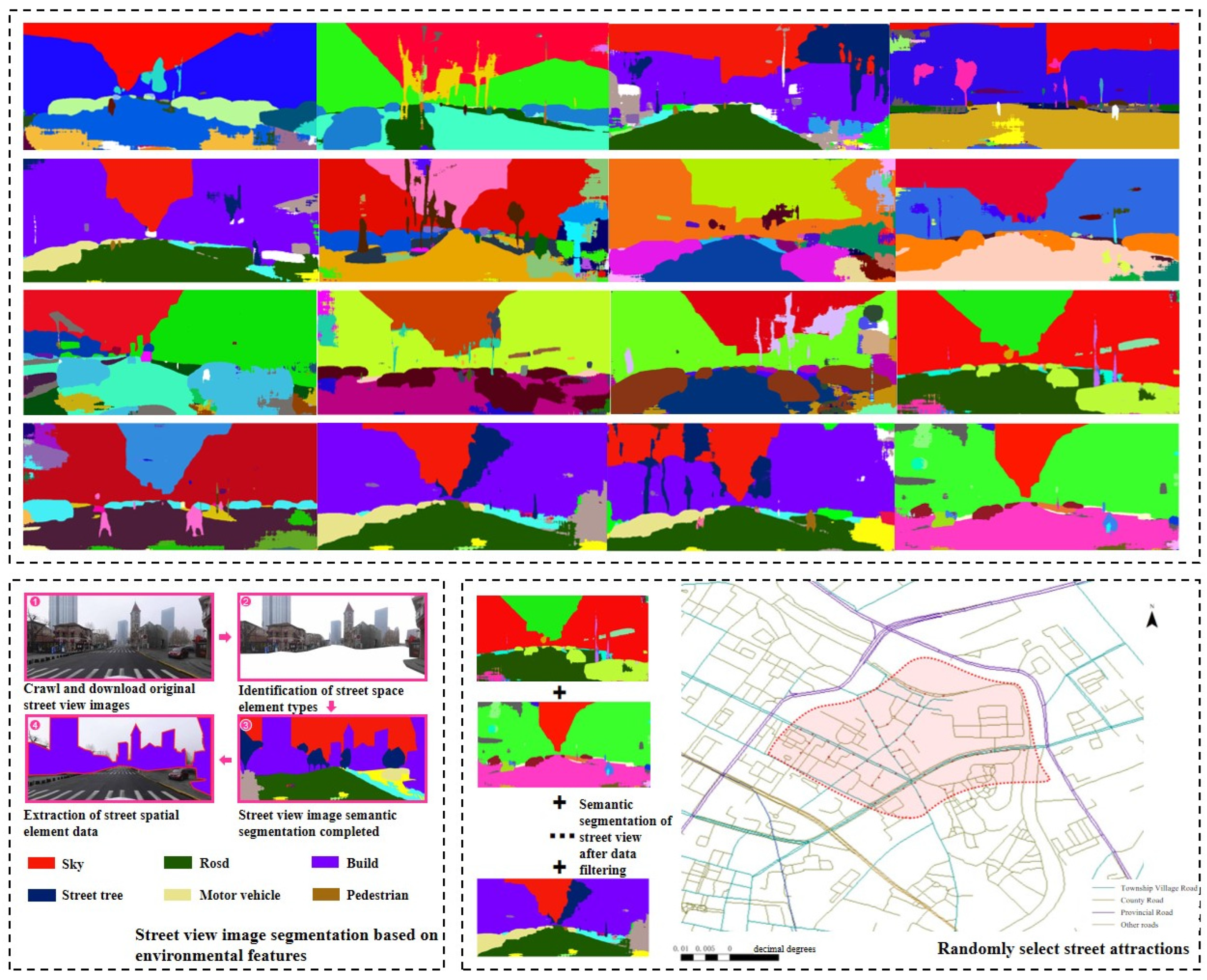Spatial Sense of Safety for Seniors in Living Streets Based on Street View Image Data
Abstract
1. Introduction
2. Literature Review
2.1. Research Aspects of the Safety Perception of Seniors in Living Street Spaces
2.2. Research Aspects of the Impact of Street View Images on the Spatial Safety Perception of Seniors
3. Materials and Methods
3.1. Research Area and Data Sources
3.2. Research Framework
3.3. Measurable Indicators of Street Space Environment
3.3.1. Data Collection and Measurement of Street Space Environmental Indicators Based on Street View Images
3.3.2. Subjective Evaluation Data on the Sense of Safety in Streets Among Seniors
4. Results
4.1. Reliability Verification
4.2. Model Establishment
4.2.1. Related Analysis: The Impact of Street Spatial Environment on Seniors’ Perception of Safety at All Levels
4.2.2. Regression Analysis: The Impact of Perceived Safety at Various Levels on Overall Perceived Safety in Street Spaces
5. Discussion
6. Conclusions
- (1)
- In terms of data source processing
- (2)
- In terms of analysis results
- (3)
- At the level of optimization strategies
Author Contributions
Funding
Data Availability Statement
Conflicts of Interest
References
- Porzi, L.; Rota Bulò, S.; Lepri, B.; Ricci, E. Predicting and Understanding Urban Perception with Convolutional Neural Networks. In Proceedings of the 23rd ACM International Conference on Multimedia, Brisbane, Australia, 26–30 October 2015; ACM: New York, NY, USA, 2015; pp. 139–148. [Google Scholar]
- Seiferling, I.; Naik, N.; Ratti, C.; Proulx, R. Green streets—Quantifying and mapping urban trees with street-level imagery and computer vision. Landsc. Urban Plan. 2017, 165, 93–101. [Google Scholar] [CrossRef]
- Zhang, L.; Pei, T.; Wang, X.; Wu, M.; Song, C.; Guo, S.; Chen, Y. Quantifying the Urban Visual Perception of Chinese Traditional-Style Building with Street View Images. Appl. Sci. 2020, 10, 5963. [Google Scholar] [CrossRef]
- Newman, O. Defensible Space; Macmillan: New York, NY, USA, 1972. [Google Scholar]
- Zhang, Y.; Lin, Q.; Zhu, C.; Mao, M.; Jiang, D. The influence of permeable environment on the distribution of theft crimes and the moderating role of social disorganization: Also on the applicability of the street-eye theory and the defensive space theory. Adv. Geogr. Sci. 2022, 41, 1041–1052. [Google Scholar]
- Jacobs, J. The Death and Life of Great American Cities; Yilin Press: Nanjing, China, 2006. [Google Scholar]
- Meng, L.; Wen, K.-H.; Zeng, Z.; Brewin, R.; Fan, X.; Wu, Q. The Impact of Street Space Perception Factors on Elderly Health in High-Density Cities in Macau—Analysis Based on Street View Images and Deep Learning Technology. Sustainability 2020, 12, 1799. [Google Scholar] [CrossRef]
- Zeng, Y.; Chen, B. Evaluation of Aging-Friendly Public Spaces in Old Urban Communities Based on IPA Method—A Case Study of Shouyi Community in Wuhan. Buildings 2024, 14, 2362. [Google Scholar] [CrossRef]
- New York Department of Transportation. Safe Streets for the Elderly; New York Department of Transportation: New York, NY, USA, 2024. [Google Scholar]
- Li, H.; Chen, C.; Liu, X.; Wu, Y.; Chen, S. Spatial Distribution Characteristics and Influencing Factors of Age-friendly Urban Streets Based on Human-centered Streetview Images. J. Geo-Inf. Sci. 2024, 26, 1469–1485. [Google Scholar]
- Chen, L.; Xu, J.; Zhang, W.; Xie, Y.; Dang, Y.; Zhan, D. Residents’ perception of urban public safety and community environment: An analysis based on a large-scale questionnaire survey in Beijing. Acta Geogr. Sin. 2021, 76, 1939–1950. [Google Scholar]
- Zhang, L.; Wang, X. Accurate Object Recognition in Street View Images Using Convolutional Neural Networks. J. Comput. Vis. Pattern Recognit. 2023, 45, 123–135. [Google Scholar] [CrossRef]
- Li, M.; Liu, Z.; Chen, H. Prediction of Traffic Flow and Pedestrian Movement Patterns Based on Convolutional Neural Networks. IEEE Trans. Intell. Transp. Syst. 2024, 15, 879–890. [Google Scholar]
- Wang, J.; Zhang, Y. Analysis of the Impact of Environmental Factors on Resident Well-being Using Convolutional Neural Networks. Environ. Sci. Technol. 2024, 58, 4567–4575. [Google Scholar]
- Huang, W.K.; Teng, F.; Wang, Z.D. A review of image segmentation based on deep learning. Comput. Sci. 2024, 51, 107–116. [Google Scholar]
- Gao, L.; Xiang, X.; Chen, W.; Nong, R.; Zhang, Q.; Chen, X.; Chen, Y. Research on Urban Street Spatial Quality Based on Street View Image Segmentation. Sustainability 2024, 16, 7184. [Google Scholar] [CrossRef]
- Pan, Z.; Liu, Y.; Liu, Y.; Huo, Z.; Han, W. Age-friendly neighborhood environment, functional abilities and life satisfaction: A longitudinal analysis of older adults in urban China. Soc. Sci. Med. 2024, 340, 116403. [Google Scholar] [CrossRef]
- Beatley, T. Biophilic Cities: Integrating Nature into Urban Design and Planning; Island Press: Washington, DC, USA, 2011. [Google Scholar]
- Alexander, C. A Pattern Language: Towns, Buildings, Construction; Oxford University Press: Oxford, UK, 1977. [Google Scholar]
- Lu, J.; Liu, P.; Wu, X. Christopher Alexander’s ‘Pattern Language’ and Its Influence in the Field of Computer Science. Stud. Dialectics Nat. 2012, 11, 104–109. [Google Scholar]
- Sussman, A.; Hollander, J. Cognitive Architecture: Designing for How We Respond to the Built Environment, 2nd ed.; Routledge: London, UK, 2021. [Google Scholar]
- Shu, S.; Chen, G.; Ma, R.; Gao, S. Pedestrian and Bicycle Traffic Enhancement Strategies Based on the Concept of Healthy Streets: A Case Study of Wangfujing Area, Beijing. Urban Transp. 2022, 20, 75–84. [Google Scholar]
- Han, X. Research on the implementation-oriented strategy for improving healthy streets: Taking the public space improvement design of Jianhua South Road Street in Beijing as an example. Huazhong Archit. 2024, 42, 131–136. [Google Scholar]
- Sun, T.; Fan, L.; Wei, X. Lessons from London’s Healthy Street Planning Experience. Planners 2020, 36, 80–86. [Google Scholar]
- Wei, H. Shaping Healthy Cities with Healthy Street Approaches: Insights from the Healthy Streets Policy of Greater London. Urban Transp. 2021, 19, 1–10. [Google Scholar]
- Liu, L.; Tu, Y.; Sun, M.; Lyu, H.; Wang, P.; He, J. Spatial Quality Measurement and Characterization of Daily High-Frequency Pedestrian Streets in Xi’an City. Land 2024, 13, 885. [Google Scholar] [CrossRef]
- Yao, Y.; Liang, Z.; Yuan, Z.; Liu, P.; Bie, Y.; Zhang, J.; Wang, R.; Wang, J. A Human-Machine Adversarial Scoring Framework for Urban Perception Assessment Using Street-View Images. Int. J. Geogr. Inf. Sci. 2019, 33, 2363–2384. [Google Scholar] [CrossRef]
- Wang, Q. A Study on the Influence of Built Environment, Psychological State, and Social Interaction on the Leisure Walking Intention of Elderly People; Taiyuan University of Science and Technology: Taiyuan, China, 2024. [Google Scholar]
- Yao, J. Reflections on Modern Community Planning and Design under Maslow’s Hierarchy of Needs. Planner 2015, 31, 140–144. [Google Scholar]
- Maslow, A.H. A theory of human motivation. Psychol. Rev. 1943, 50, 370–396. [Google Scholar] [CrossRef]
- Qi, L. Statistical analysis of the Likert scale and fuzzy comprehensive evaluation. Shandong Sci. 2006, 2, 18–23+28. [Google Scholar]
- Yao, Y.; Wang, J.L.; Hong, Y.; Qian, C.; Guan, Q.; Liang, X.; Dai, L.; Zhang, J. Discovering the homogeneous geographic domain of human perceptions from street view images. Landsc. Urban Plan. 2021, 212, 104125. [Google Scholar] [CrossRef]
- Wang, R.Y.; Liu, Y.; Lu, Y.; Yuan, Y.; Zhang, J.; Liu, P.; Yao, Y. The linkage between the perception of neighbourhood and physical activity in Guangzhou, China: Using street view imagery with deep learning techniques. Int. J. Health Geogr. 2019, 18, 18. [Google Scholar] [CrossRef]
- Sun, D.; Ji, X.; Gao, W.; Zhou, F.; Yu, Y.; Meng, Y.; Yang, M.; Lin, J.; Lyu, M. The Relation between Green Visual Index and Visual Comfort in Qingdao Coastal Streets. Buildings 2023, 13, 457. [Google Scholar] [CrossRef]
- Zhu, J.; Li, B.; Ouyang, H.; Wang, Y.; Bai, Z. Understanding Urban Residents’ Walking Exercise Preferences: An Empirical Study Using Street View Images and Trajectory Data. Buildings 2024, 14, 549. [Google Scholar] [CrossRef]
- Gehl, J. Places for People: Meboume; City of Meboume: Melbourne, Australia, 2004. [Google Scholar]
- Gehl, J.; Gemzoe, L. Public Spaces, Public Life; Tang, Y., Translator; China Architecture & Building Press: Beijing, China, 2003. [Google Scholar]
- Zhou, L.; Hu, J.; Liu, Y. The Impact of Outdoor Activity Spaces in Hainan Communities on the Health Perception of seniors. Urban For. China 2022, 20, 42–47. [Google Scholar]
- Guo, N.; Xia, F.; Yu, S. Enhancing Elderly Well-Being: Exploring Interactions between Neighborhood-Built Environment and Outdoor Activities in Old Urban Area. Buildings 2024, 14, 2845. [Google Scholar] [CrossRef]
- Wang, Z. Research on Community Livability Street Renewal Strategies Based on Emotion Perception; North China University of Technology: Beijing, China, 2024. [Google Scholar]
- Lu, M.; Zhang, Y.; Liu, X.; Bai, Z. Research on Urban Residents’ Safety Psychological Perception from the Perspective of Community Public Space Safety. Mod. Urban Res. 2019, 8, 125–130. [Google Scholar]
- Witten, K.; Macmillan, A.; Mackie, H.; van der Werf, B.; Smith, M.; Field, A.; Woodward, A.; Hosking, J. Te Ara Mua—Future Streets: Can a streetscape upgrade designed to increase active travel change residents’ perceptions of neighborhood safety, well-being. Space Soc. 2022, 3, 100079. [Google Scholar] [CrossRef]
- Xu, L.; Jiang, W.; Chen, Z. Study on the sense of security in public spaces: A case study of urban street scene perception in Shanghai. Landsc. Archit. 2018, 25, 23–29. [Google Scholar]
- Fang, Z.; Wang, R.; Liu, C. Research on the Impact of Street Environment on Individual Sense of Security Based on Multi-source Data. J. Shanghai Urban Plan. Rev. 2023, 2, 109–115. [Google Scholar]
- Wei, Y.; Yang, D. Evaluation on the Built Environment Support for the Neighborhood Destinations of the Elderly’s Daily Activities: A Case Study of Dalian City. City Plan. Rev. 2024, 48, 59–71. [Google Scholar]
- Sussman, A. Using Eye Tracking to Reveal Responses to the Built Environment and Its Constituents. Appl. Sci. 2023, 13, 12071. [Google Scholar] [CrossRef]







| Application Dimension | Measurement Index | Index Interpretation | Measure Method |
|---|---|---|---|
| Measurable indicators of street space environment | Street green view rate | The green space area perceived by pedestrians in street space. | Percentage of pixel area of landscape greening elements in street view images. |
| Sky openness | The area of the sky visible to pedestrians in street space. | Percentage of pixel area of sky elements in street view images. | |
| Enclosure of the interface | The enclosed feeling formed in street space. | Percentage of pixel area of buildings and structures in street view images. | |
| Field of view identification degree | Directional signage system within street spaces. | The pixel area proportion of elements such as traffic signs, traffic lights, etc., in street view images. | |
| Pedestrian activity level | Frequency of pedestrians appearing in street spaces. | Percentage of pedestrian pixel area in street view images. | |
| Motor vehicle activity | Area of motor vehicles in street space. | Percentage of pixel area of motor vehicles in street view images. | |
| Seating space | The space that can be sat in formed in the street space. | Percentage of pixel area of rest space elements in street view images. |
| Measurement Index | Street View Elements | Indicator Project |
|---|---|---|
| Street green view rate | Plants | Trees; Grass; Plants |
| Sky openness | Sky | Sky |
| Enclosure of the interface | Enclosure by buildings and structures | Walls; Buildings; Ground; Fences |
| Field of view identification degree | Directional signage facilities and systems | Posts; Shop signs; Trademarks; Street lights; Poles; Sculptures; Traffic lights; Monitors; Flags |
| Pedestrian activity level | Non-motorized vehicle | Roads; Sidewalks; Pedestrians; Animals |
| Motor vehicle activity | Motor vehicle | Cars; Buses; Trucks; Vans; Small locomotives; Steps; Bicycles; Railways |
| Seating space | Seating space | Seats |
| Street imaginability | The uniqueness, recognizability, and impressive level of street space | Artificial audit element: Subjective scoring of street view images using expert scoring methods. The measurement results are subjective and will not be considered for the time being |
| Pedestrian pavement smoothness | Degree of completeness of pedestrian rights of way | |
| Cleanliness of pedestrian interface | The degree of old, damaged, and chaotic building facades and floors | |
| Coordination of street facilities | The coordination level of basic public facilities such as street facilities, isolation facilities, and cycling road networks |
| Application Dimension | Measurement Index | Index Interpretation | Measure Method | |
|---|---|---|---|---|
| Measurable indicators of street space environment | Street green view rate | The green space area perceived by pedestrians in street space | Percentage of pixel area of landscape greening elements in street view images | |
| Sky openness | The area of the sky visible to pedestrians in street space | Percentage of pixel area of sky elements in street view images | ||
| Enclosure of the interface | The enclosed feeling formed in street space | Percentage of pixel area of buildings and structures in street view images | ||
| Field of view identification degree | Directional signage system within street spaces | The pixel area proportion of elements such as traffic signs, traffic lights, etc., in street view images | ||
| Pedestrian activity level | Frequency of pedestrians appearing in street spaces | Percentage of pedestrian pixel area in street view images | ||
| Motor vehicle activity | Area of motor vehicles in street space | Percentage of pixel area of motor vehicles in street view images | ||
| Seating space | The space that can be sat in formed in the street space | Percentage of pixel area of rest space elements in street view images |
| Five Different Types of Security Perception | Interpretation of Indicators |
|---|---|
| Sense of spatial security | The perception of seniors feeling comfortable, safe, and relaxed in street spaces, for example, carefully designed street layouts and clear spatial boundaries. |
| Sense of security during walking behavior | It will affect the willingness and safety level of seniors to walk in the street space. This is related to factors such as street environment and traffic conditions. |
| Sense of security in visual perception and identification | It affects the visual recognition and assessment of the safety of the street environment by seniors in the street space, such as the visibility of the logo and the clarity of the field of view. |
| Sense of security during rest and relaxation | It will affect seniors’ choice of resting place, reflecting their need for a safe and comfortable resting place on the street. |
| Sense of security during social interaction activities | It reflects the sense of security that seniors feel when engaging in social activities in street spaces. A good street space environment can directly affect the safety of space use and the sustainability of social activities. |
| Subject | Options | Frequency | Percentage (%) | Cumulative Percentage (%) |
|---|---|---|---|---|
| Age | 60–69 years old | 8 | 23.53 | 23.53 |
| 70–79 years old | 20 | 58.82 | 82.35 | |
| 80 years old and above | 6 | 17.65 | 100 | |
| Gender | Female | 18 | 52.94 | 52.94 |
| Male | 16 | 47.06 | 100 | |
| Duration of residence in this community | 1–3 years | 1 | 2.94 | 2.94 |
| More than 3 years | 1 | 2.94 | 5.88 | |
| 3–10 years | 6 | 17.65 | 23.53 | |
| 10–30 years | 20 | 58.82 | 82.35 | |
| Over 30 years | 6 | 17.65 | 100 | |
| Highest education level | Elementary school and below | 7 | 20.59 | 20.59 |
| Junior high school | 14 | 41.18 | 61.76 | |
| High school/vocational school | 11 | 32.35 | 94.12 | |
| College/Bachelor’s degree | 2 | 5.88 | 100 | |
| Personal monthly income | nothing | 3 | 8.82 | 8.82 |
| Less than CNY 2000 | 9 | 26.47 | 35.29 | |
| CNY 2000–4000 | 8 | 23.53 | 58.82 | |
| CNY 4001–6000 | 10 | 29.41 | 88.24 | |
| CNY 6001–8000 | 3 | 8.82 | 97.06 | |
| CNY 8001–10,000 | 1 | 2.94 | 100 | |
| Total | 34 | 100 | 100 | |
| Adjectives Describing Sense of Security in Street Spaces | Average Score |
|---|---|
| Spatial security | 2.962 |
| Sense of security during walking behavior | 2.850 |
| Sense of security in visual field perception | 3.126 |
| Sense of security during rest and relaxation | 3.124 |
| Sense of security in social interactions | 3.023 |
| Average score of perceived safety in street spaces | 3.017 |
| Cronbach Confidence Analysis | ||
|---|---|---|
| Number of Terms | Sample Size | Cronbach’s α Coefficient |
| 5 | 34 | 0.71 |
| Pearson Correlation Analysis | ||
|---|---|---|
| Measurable Indicators of Street Space Environment | Space Security Score | |
| Correlation Coefficient | p-Value | |
| Street green view rate | 0.303 | 0.048 * |
| Sky openness | −0.481 | 0.037 * |
| Enclosure of the interface | 0.318 | 0.086 |
| Field of view identification degree | −0.137 | 0.037 * |
| Pedestrian activity level | −0.021 | 0.913 |
| Motor vehicle activity | −0.291 | 0.241 |
| Seating space | 0.017 | 0.931 |
| Pearson Correlation Analysis | ||
|---|---|---|
| Measurable Indicators of Street Space Environment | Safety Score for Walking Behavior | |
| Correlation Coefficient | p-Value | |
| Street green view rate | 0.162 | 0.039 * |
| Sky openness | −0.118 | 0.535 |
| Enclosure of the interface | −0.221 | 0.024 * |
| Field of view identification degree | −0.006 | 0.975 |
| Pedestrian activity level | 0.049 | 0.798 |
| Motor vehicle activity | 0.181 | 0.048 * |
| Seating space | 0.009 | 0.964 |
| Results of the Linear Regression Analysis (n = 34) | |||||||
|---|---|---|---|---|---|---|---|
| Non-Standardized Coefficients | Standardization Coefficient | t | p | 95%CI | VIF | ||
| B | Standard Error | Beta | |||||
| Constant | 0.045 | 0.174 | - | 0.257 | 0.799 | −0.297~0.386 | - |
| Spatial security | 0.459 | 0.145 | 0.444 | 3.172 | 0.003 ** | 0.176~0.743 | 2.557 |
| Sense of security during walking behavior | 0.567 | 0.132 | 0.565 | 4.302 | 0.001 ** | 0.309~0.825 | 2.249 |
| Sense of security in visual field perception | −0.385 | 0.118 | −0.037 | −0.321 | 0.002 * | −0.269~0.193 | 1.744 |
| Sense of security during rest and relaxation | −0.059 | 0.126 | −0.058 | −0.468 | 0.643 | −0.306~0.188 | 2.029 |
| Sense of security in social activities | −0.07 | 0.136 | 0.324 | −0.278 | 0.611 | −0.306~0.188 | 2.01 |
| Pearson Correlation Analysis | ||
|---|---|---|
| Measurable Indicators of Street Space Environment | Safety Score for Visual Field Perception and Identification | |
| Correlation Coefficient | p-Value | |
| Street green view rate | 0.387 | 0.035 * |
| Sky openness | 0.248 | 0.285 |
| Enclosure of the interface | 0.349 | 0.018 * |
| Field of view identification degree | −0.078 | 0.680 |
| Pedestrian activity level | 0.015 | 0.937 |
| Motor vehicle activity | 0.241 | 0.200 |
| Seating space | −0.109 | 0.568 |
| Pearson Correlation Analysis | ||
|---|---|---|
| Measurable Indicators of Street Space Environment | Rest and Relaxation Safety Score | |
| Correlation Coefficient | p-Value | |
| Street green view rate | 0.027 | 0.190 |
| Sky openness | 0.062 | 0.069 |
| Enclosure of the interface | −0.214 | 0.264 |
| Field of view identification degree | 0.162 | 0.400 |
| Pedestrian activity level | 0.265 | 0.164 |
| Motor vehicle activity | 0.174 | 0.367 |
| Seating space | −0.148 | 0.443 |
| Pearson Correlation Analysis | ||
|---|---|---|
| Measurable Indicators of Street Space Environment | Security in Social Activities Score | |
| Correlation Coefficient | p-Value | |
| Street green view rate | 0.113 | 0.560 |
| Sky openness | −0.357 | 0.057 |
| Enclosure of the interface | −0.058 | 0.766 |
| Field of view identification degree | 0.184 | 0.340 |
| Pedestrian activity level | 0.191 | 0.321 |
| Motor vehicle activity | −0.112 | 0.563 |
| Seating space | −0.152 | 0.430 |
Disclaimer/Publisher’s Note: The statements, opinions and data contained in all publications are solely those of the individual author(s) and contributor(s) and not of MDPI and/or the editor(s). MDPI and/or the editor(s) disclaim responsibility for any injury to people or property resulting from any ideas, methods, instructions or products referred to in the content. |
© 2024 by the authors. Licensee MDPI, Basel, Switzerland. This article is an open access article distributed under the terms and conditions of the Creative Commons Attribution (CC BY) license (https://creativecommons.org/licenses/by/4.0/).
Share and Cite
Sun, X.; Nie, X.; Wang, L.; Huang, Z.; Tian, R. Spatial Sense of Safety for Seniors in Living Streets Based on Street View Image Data. Buildings 2024, 14, 3973. https://doi.org/10.3390/buildings14123973
Sun X, Nie X, Wang L, Huang Z, Tian R. Spatial Sense of Safety for Seniors in Living Streets Based on Street View Image Data. Buildings. 2024; 14(12):3973. https://doi.org/10.3390/buildings14123973
Chicago/Turabian StyleSun, Xuyang, Xinlei Nie, Lu Wang, Zichun Huang, and Ruiming Tian. 2024. "Spatial Sense of Safety for Seniors in Living Streets Based on Street View Image Data" Buildings 14, no. 12: 3973. https://doi.org/10.3390/buildings14123973
APA StyleSun, X., Nie, X., Wang, L., Huang, Z., & Tian, R. (2024). Spatial Sense of Safety for Seniors in Living Streets Based on Street View Image Data. Buildings, 14(12), 3973. https://doi.org/10.3390/buildings14123973






